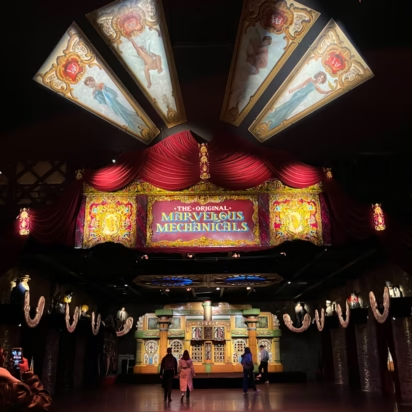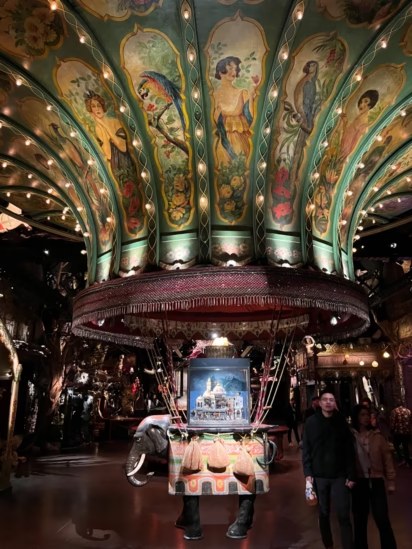The Museum of Fairground Arts (Musée des Arts Forains) in Paris, Bercy, is a fun, family-friendly Belle Époque funfair experience with historic carousel rides.

Visit the Museum of Fairground Arts (Musée des Arts Forains) in Paris’s Bercy district for a captivating journey into Belle Époque fairground culture. Its vast collection of more than 3,000 restored objects, including carousel figures, sideshow games, mechanical wonders, and theatrical décor, makes it the largest museum of its kind in the world. It is only 15 minutes from the heart of Paris, but it feels a world away. The museum is only seen on fun guided tours — online time-slot reservations are essential.
Museum of Fairground Arts (Musée des Arts Forains)

The lively Musée des Arts Forains Les Pavillons de Bercy is a fun museum to visit for families and travelers of all ages. It is the most entertaining museum in Paris, as visitors are guided through atmospheric halls that bring to life the charm, color, and imagination of late-19th and early-20th-century fun fairs in France.
While the guide explains the main sights in each hall, visitors are mostly free to explore the room and touch almost any objects. There are no descriptions to study — enjoy simply by sight or ask for clarifications. Visitors also enjoy a few rides, participate in games, and dance — no pressure, and they go a few rounds if necessary to give everybody a turn.
Main halls and themes in the fairgrounds museum include:
- The Pavilions of Bercy — a short explanation on the role that this area historically played in entertainment in Paris. Being just outside the city gates, Bercy was free of taxation on wine. Parisians came for the cheap booze and raunchy entertainment.
- Les Salons Vénitiens — the Venetian Saloons with a fairground carousel, the famous carnival, games, and a night at the opera.
- Salons Carousels — mobile Belle Epoque fairgrounds that moved from town to town with a huge organ, a ballroom for dancing, carousels, games, bars, and electricity! The original salon, now stationary and in parts inside the museum, had a 40 m (130 feet) facade and required 18 wagons for transportation.
- Le Théâtre du Merveilleux — cabinet of curiosities, illusions, games (including horse racing, target shooting), a ballroom, and the marvelous bicycle carousel.
The museum is family-friendly, but like the fairgrounds of the Belle Epoque, the focus is on adults. The carousels are ideal for those not keen on high-speed, stomach-churning rides.
Fairgrounds of the Belle Epoque
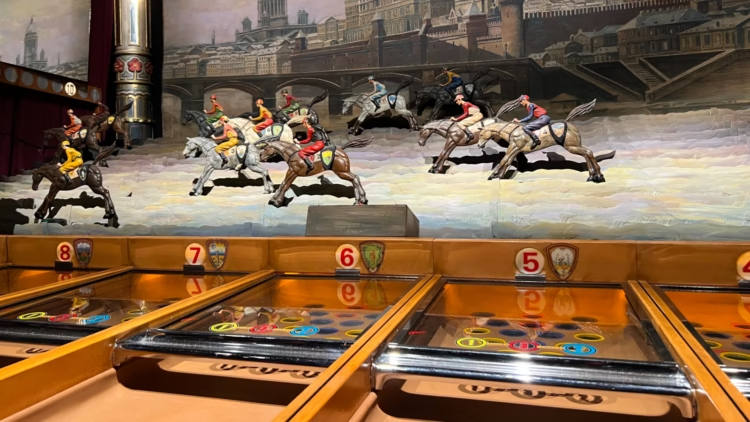
The engaging guides casually drop interesting observations without turning the visit into a history lesson. Each guide arranges their own tour — visitors with the English information sheet probably get more facts (but fewer jokes). Tours take 90 minutes.
Some remarks that I found interesting:
Then, as now, you visited fairgrounds for entertainment. This included games, carousels, music, dancing, shows, mechanical theaters, cinema, lotteries, fortunetelling, eating, and drinking. Early visitors saw electricity for the first time at funfairs. Showmen and scientific demonstrations also attracted huge interest.
Fairgrounds of the Belle Epoque were for adults, which explains the size of the horses. (Nevertheless, children are most welcome here. In our tour, the ages ranged from mid-20s to late 60s, but the shrieks of joy from the tours before and after ours left no doubt that smaller children and teenagers were having fun too!)
Napoleon Bonaparte cancelled the Venetian carnival in 1797 out of fear that rioters could hide behind the masks. The legend lived on in endless imitations, but carnival officially resumed in Venice only in 1980.
Horses were for the nobility, rich, and military — for many average Europeans, especially city dwellers, the fairground carousel animals were the only opportunity to experience what riding a horse was like.
Carousel horses face outward to attract attention. Much as with driving today, European horses face right for anti-clockwise rotation, while English horses face left with the carousel turning clockwise.
The Mortier organ (1932), used in the dance hall, replaced 12 musicians. On a calm day, the Hooghuys pipe organ of the mobile salon could alert folk 2 to 3 km away that the funfair was in town.
Highlight: Riding the Bicycle Carousel

A personal highlight was riding the bicycle carousel. Built in Belgium in 1897, the mechanics are British (so we went clockwise), the paintwork French, and the organ Italian.
Purely pedal-powered, the carousel could reach speeds of up to 40 mph (60 km/h). This was sensational at a time when only a few had ever experienced such velocity. A galloping horse could probably go at half the pace, while the British speed limit at the time was a more sedate 14 mph (23 km/h).
Fun to ride and beautiful to look at. This bicycle carousel featured in Woody Allen’s movie Midnight in Paris.
Visitor Information: Museum of Fairground Arts (Musée des Arts Forains) in Paris
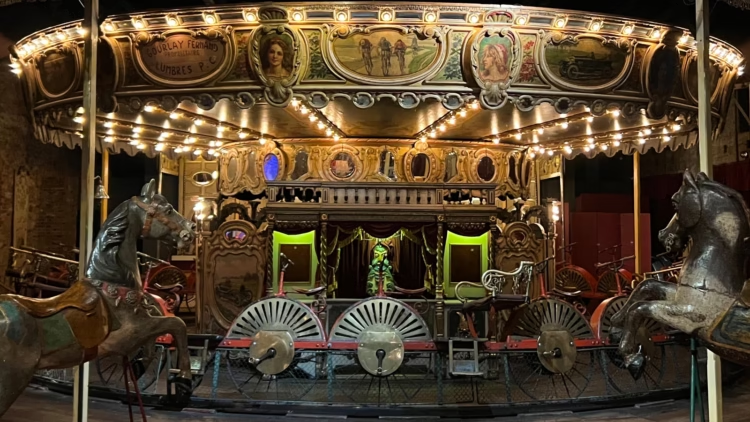
Opening Hours, Tours and Ticket Prices
The Museum of Fairground Arts (Musée des Arts Forains) is only open for 90-minute guided tours, which must be reserved online in advance. Reservations are only possible directly through the museum’s official website.
Admission tickets, which include the obligatory guided tour, cost around €20 for adults and €15 for children aged 4 to 11 years old. (Note that groups of 9 or more must make a group reservation.) (The Paris Museum pass is not valid.)
Tours are most likely on Wednesday and weekends, but more frequently during French school holidays.
Tours are mostly bookable only around two to three weeks in advance. Check dates frequently and early — English tours are limited and book out quickly. French tours are far more common and still fun for non-French speakers.
If needed, ask at the kiosk for the information sheet in English. It starts with this beauty, which accurately sets the tone for the whole visit:
This handout is designed to give you keys to help you follow the tour. All the information provided by the guide is in this document, except for the unscripted guide’s jokes. And don’t worry, if you see visitors laughing, they are just being polite, the jokes are not always that funny ;)
Arrive at the museum at most 10 minutes before the tour time. There are no waiting spaces, cafe, or shop directly at the museum venue itself.
During the Christmas and New Year’s holidays, from around 26 December to 4 January, the museum is open for the Festival du Merveilleux. During the festival, no tours are given, with visitors able to roam freely and enjoy a variety of shows and performances.
Transportation to the Museum of Fairground Arts (Musée des Arts Forains) in Paris
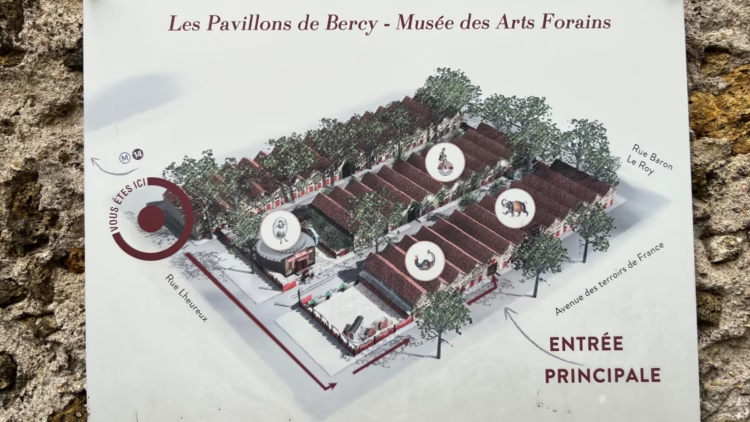
Getting to the Museum of Fairground Arts (Musée des Arts Forains) in Les Pavillons de Bercy, 53 Av. des Terroirs de France, 75012 Paris, France, is easy on public transportation. It is located just south of the Parc de Bercy, behind Bercy station and the Gare de Lyon. Although many true Parisians often considered this the outskirts and in the back of beyond, it can now easily be reached by metro M14 in 2 minutes from Gare de Lyon, 6 minutes from Les Halles-Chatelet, 10 minutes from Madeleine, or 20 minutes from Orly Airport (but remember Airport metro surcharges).
The closest metro station to the fairground museum is Cour Saint-Émilion on the Metro Line M14. From exit 1, it is a five-minute walk. Cross straight through the small Bercy Village shopping mall (many small fast-food and coffee shops) and down Rue Lheureux. The museum entrance is on Avenue des Terroirs de France.
There are no cafes or waiting spaces at the museum itself, so spend time closer to the shopping mall or in the park if arriving early.
Metro M14 is often closed on weekends and national holidays for maintenance work. An alternative is the Gare de Bercy metro station (on lines M6 and M14), from where it is a 15-minute walk. Bus services are also available.
